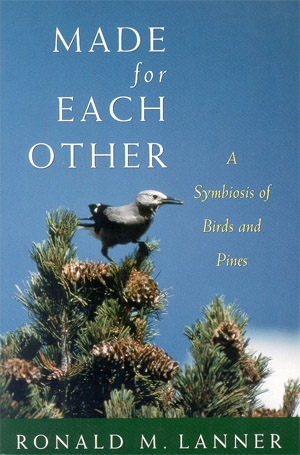 Oxford University Press, New York, USA, 1996, 160 pages, color & black-and-white photographs, line drawings, tables, maps, bibliography, index
Oxford University Press, New York, USA, 1996, 160 pages, color & black-and-white photographs, line drawings, tables, maps, bibliography, indexSCIENCE / ECOLOGY
Some trees and birds are made for each other. Take, for example, the whitebark pine, a timberline tree that graces the moraines and ridgetops of the northern Rockies and the Sierra Nevada-Cascades system. This lovely five-needled pine, long-lived and rugged though it is, cannot reproduce without the help of. Clark's Nutcracker. And the nutcracker, though it captures insects in the summer and steals a bit of carrion, cannot raise its young in these alpine habitats without feeding them the nutritious seeds of the whitebark pine. Between them, these dwellers of the high mountains provide for each others' posterity, which leads biologists to label their relationship symbiotic, or mutualistic. But there is more to it than that, because in playing out their roles these partners change the landscape. The environment they create provides life's necessities to many other plants and animals. Working in concert Clark's Nutcracker and the whitebark pine build ecosystems.
In Made for Each Other: A Symbiosis of Birds and Pines, Ronald M. Lanner details for the first time this fascinating relationship between wingless-seeded pine trees and seed-dispersing Corvids (nutcrackers and jays), showing how mutualism can drive not only each others' evolution, but affect the ecology of many other members of the surrounding ecosystem as well. In a complex process of mutual dependency, myriad species of both plants and animals-from Engelmann spruce, elk, and moose to red squirrels, bear, and fungi-advance the overall life cycle by taking advantage of the ecological terrain that precedes them. Focusing on the Rocky Mountains and the American Southwest, and ranging as far afield as the Alps, Finland, Siberia, and China, this beautifully illustrated and gracefully written work illuminates the phenomenon of co-evolution
Ronald M. Lanner is Professor Emeritus of Forest Resources at Utah State University. He is the author of a number of books, including The Piñon Pine, Trees of the Great Basin, Autumn Leaves: A Guide to the Fall Colors of the Northwoods, and the forthcoming, The Conifers of California.
Cover photograph by Ronald M, Lanner
Cover design by David Tran